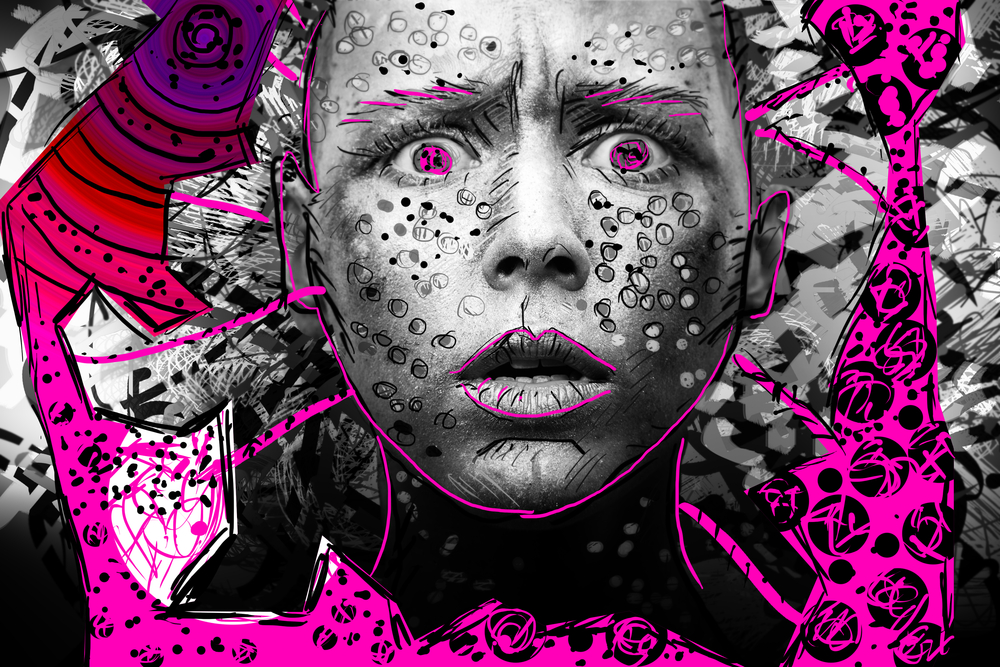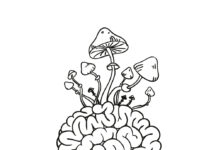In a recent article published in Transcultural Psychiatry, researcher Phoebe Friesen from McGill University examined the contrasting research paradigms on psychedelics versus psychosis, suggesting that how the two mind-altering experiences are investigated helps to reveal the goals and assumptions behind each research paradigm.
Friesen provides valuable lessons that psychiatric researchers can learn from the compassionate approach employed with individuals undergoing a psychedelic experience, which stands in stark contrast to the treatment of those in a psychotic state of consciousness.
“If we do not take stock of the important lessons that can be learned from psychedelic sciences related to meaning and mysticism, set and setting, and care and compassion, we risk creating another psychiatric science that unhappily fits a mold constructed for biomedical research,” Friesen writes. “If, on the other hand, we listen to the ways in which experiences of psychedelics and psychosis refuse to fit this mold, we might end up with a much greater understanding of these curious, and challenging, states of consciousness.”
 In the mid-20th century, researchers thought that psychedelics provided critical insights into novel research for psychosis, promoting the notion that the psychedelic experiences mimicked the psychotic experience. Much of the research being conducted at the time explored the “psychedelic model of psychosis,” and there was fervor within the field of psychiatry about the insight this might provide researchers by using psychedelics as a modality to investigate “madness.”
In the mid-20th century, researchers thought that psychedelics provided critical insights into novel research for psychosis, promoting the notion that the psychedelic experiences mimicked the psychotic experience. Much of the research being conducted at the time explored the “psychedelic model of psychosis,” and there was fervor within the field of psychiatry about the insight this might provide researchers by using psychedelics as a modality to investigate “madness.”
With psychoanalytic trends at the center of psychiatry in the mid-20th century, exploring the subjective nature of patients’ experiences was common practice across mental disorders. Madness was considered rich with hidden meaning rather than a mere abnormality that needed symptom reduction. Interestingly, it was often common practice for those working with psychotic patients to experiment with psychedelics themselves to increase their sense of empathy and deepen their understanding of their patients’ psychotic experiences.
Researchers had a continued focus on comparing psychedelic experiences to psychosis to understand the phenomenon better. They noted many parallels between both states of consciousness, such as ego dissolution, elation, anxiousness, and dysphoria. While there were similarities between states, researchers also noted vital differences. First, in most cases, experiences brought about by psychedelics were intentionally brought about, while experiences of psychosis were not. Second, psychedelic experiences are short-lived, lasting for several hours on average, while experiences of psychosis do not come with a guaranteed endpoint.
The Disentanglement of Psychedelics and Psychosis Work
The moral panic of the 1960s ultimately shut down psychedelic research and disentangled psychosis and psychedelic work. Psychedelic drugs were categorized as dangerous, leading pharmaceutical companies to halt their distribution for medical research. Despite significant opposition from researchers in this field, psychedelic research programs were universally shut down. Furthermore, the psychoanalytic model, although imperfect, provided room for subjectivity and the exploration of meaning. However, it was subsequently supplanted by the bio-medical model, resulting in pharmacological interventions becoming the primary form of treatment. Research funding began prioritizing neuroscientific and genetic investigations of mental disorders, especially schizophrenia.
With the ongoing new wave and reemergence of psychedelic research (e.g., Center for Psychedelic and Consciousness Research), there still has not been an emergence on how psychedelics may mimic madness or the lessons that might be learned by pursuing this path. Most research with psychedelics focuses on depression, traumatic stress, and addiction and tends to steer clear from any association with psychosis patients. Partly driven by a deliberate rebranding effort to reduce the stigma surrounding psychedelics, individuals who endorse the psychedelic model of psychosis are still intrigued by the question of how closely psychedelic states resemble naturally occurring psychotic conditions.
This begs the question of how we decide what is worth measuring in each research program. For example, in psychedelic research, it is widely understood that meaningful and even mystical experiences are powerful tools for our psyche. In fact, there are even validated measures that assess mysticism, ego dissolution, and consciousness that are frequently used in psychedelic research.
In stark contrast, psychosis research, and measurement scales focus almost strictly on the presence and severity of “symptoms,” narrowly focusing on hallucinations, paranoia, disorganization, hostility, grandiosity, and withdrawal. Friesen writes:
“These distinct foci reveal goals and assumptions that characterize these two research paradigms. Psychedelic research often characterizes these drugs as tools that can generate profoundly meaningful experiences, leading to increased well-being. On the other hand, psychosis is seen as a pathological state, not worthy of further examination beyond initiatives seeking to erase it.”
Despite the many similarities that were observed between experiences of psychedelics and psychosis that were recorded in the mid-20th century, these different outcome measures and vantages reveal how the scientific practices serve to make some features visible and obscure others depending on one’s diagnosis – be it schizophrenia, or someone with depression undergoing psychedelic-assisted treatment.
Additionally, psychedelic research encourages participants to speak for themselves and describe their experiences. On the other hand, very little psychosis research asks those with lived experience to describe the phenomenological nature of their experience. While this may be in part due to patients enduring prolonged psychotic states, whereas a psychedelic trip has a clearer endpoint, it reveals a distinction between these two programs of research related to assumptions about expertise and the relative worth of exploring the subjectivity of participants. This distinction is also evident in media coverage, where research highlighting how psychedelics can provide meaning and relief to terminal cancer patients is frequently featured. In contrast, psychosis tends to be portrayed in the news as an explanation for violent behavior.
Further, an encounter with a person who has taken psychedelics often is met with laughter and empathy, whereas an encounter with someone experiencing psychosis often leads to a 911 call.
This all points to how positive experiences during psychotic episodes are commonly overlooked, and there is a singular focus on the “pathological.” Qualitative research with those with lived experience with psychotic disorders has stated that “No one has ever asked me detailed questions about what I experience … no one has tried to understand how this has affected who I am, no one has listened to the complications, to the richness, to the good things as well as the bad.”
Set & Setting versus Biological Reductionism
Set and setting is a term initially coined by American psychologist Timothy Leary, highlighting one’s psychological “set,” including expectations, intentions, and personality, as well as the environmental setting, the physical, social, and cultural aspects of one’s context. All of this is known to influence psychedelic experiences. Therefore, within research, it has become a priority for participants to be supported by multiple warm and empathetic healthcare providers throughout their trip. Attempts have been made to remove the aspects of a clinic that can feel sterile to create warm, inviting, safe spaces for participants.
In contrast to psychosis research, set and setting are rarely considered or explored, and it is safe to say that inpatient hospitals or emergency departments, where many are admitted during or after a psychotic experience, are not the warmest environments. Despite the lack of evidence for the leading theories of schizophrenia (e.g., dopamine model, serotonin hypothesis, and glutamate hypothesis), these models reinforce a focus on neurotransmitters in psychotic experiences.
“Research into psychosis largely fails to examine the sets and settings that may be contributing to the development and nature of these experiences, focusing instead on lower-level mechanisms that might contribute to, or might reduce psychotic symptoms. As a result, there is little space for curiosity about what factors shape the phenomenological experiences of psychosis and how they might be harnessed to bring about meaningful lessons or narratives.”
Care and Compassion versus Coercion
These drastically different foci in psychedelic and psychosis research shape how professionals and lay people respond to individuals with these experiences. For psychedelic users, there is what is known as “psychedelic first aid,” in which people encountering psychedelic users (be they healthcare providers or volunteers at festivals) are trained to help individuals orient towards transforming unpleasant or even terrifying experiences into a positive and transformative one. Care and compassion are foundational in this approach.
Once again, in stark contrast, those experiencing psychosis are often met by “psychiatrists in blue,” meaning law enforcement who have been sent on a “wellness check.” Police are often trained to use force, which has sometimes resulted in death. Further, these coercive methods are more frequent in police response to Black, Indigenous, and People of Color, who are also more likely to encounter police during a pathway to care when experiencing psychosis. The author writes:
“If it is the case that experiences of psychedelics and psychosis are phenomenologically quite similar, these radical differences in responses from people meant to provide support are striking. While it is often understood that those going through challenging and sometimes terrifying experiences after ingesting psychedelics require unwavering support, compassion, and guidance, individuals experiencing psychosis are often sedated and restrained.”
Based on the comparative differences in the focus of research and treatment for individuals who have undergone a psychedelic substance to those experiencing psychosis, the author lays out lessons for psychiatric science.
First, they recommend recognizing the double-edged nature of psychosis and creating space to acknowledge not only the difficult and negative experiences but making space for how they can be experienced as meaningful and even healing.
“If clinicians lack an understanding of the aspects of psychosis that do not fit within DSM criteria, those aspects may fail to be acknowledged within the clinical encounter, even if they are central or meaningful to a given individual…clinical training ‘generally fails to equip front-line practitioners with the confidence to pursue the sort of mutual dialogue that would, in theory, allow the meaning and complexity of psychotic experiences to emerge.’ This suggests that decisions made early in a scientific research program, related to what is worth measuring, can have a significant impact on stakeholders down the line.”
Second, they recommend making space for set and setting in psychosis research, which was acknowledged in the early days of psychosis and psychedelic research and provided valuable information for the current time. While some modern research does document how environmental factors and expectations impact both the likelihood and nature of psychosis, it’s a marginalized subject in the field of psychiatry.
This is especially needed given global research on schizophrenia has indicated that those in low-and middle-income countries fare better and recover faster than those in high-income countries, such as the United States. Given how much money is spent on treatment in high-income countries, this raises significant questions regarding how set and setting might influence the efficacy of care provided. In addition, while the various biomedical theories of schizophrenia have failed to be proven, there is substantial evidence of the social determinants of psychosis, further indicating the need to incorporate set and setting into research and treatment.
And finally, the author urges psychiatry to recognize the efficacy of creating a non-judgmental holding space and empathetically caring for those experiencing psychiatric distress. This is especially crucial for crisis response, and there are ample models to follow that provide alternatives to police response and wellness checks (e.g., CAHOOTS, Soteria House). In closing, the author states:
“If we want to rethink the ways we respond to people in crisis, as is increasingly being proposed today, looking to psychedelic settings may offer some helpful guidance.”
****
Friesen, P. (2022). Psychosis and psychedelics: Historical entanglements and contemporary contrasts. Transcultural Psychiatry, 136346152211291. https://doi.org/10.1177/13634615221129116 (Link)















This is a culture of categorization, where one aspect is associated with luxury while the other is considered a political act. My perspective is influenced by individuals like Ignacio Martin-Baro and others. If we genuinely aim to assist individuals experiencing psychosis in meaningful ways, the entire political system of the West would inevitably crumble. This is because the system relies on narratives and language than reality rooted in the physical body and the movement of the body more like concepts versus materiality. Concept are derivative and material is the real source for the concepts. There are no concept without a body to observe.
Anyhow, if those experiencing psychosis were to cease and all that acquired knowledge during their “unintentional” state of unconsciousness would come to live, that will bring a transformative shift that will make the earth the centre of the human body not the other way around.
So those who oppose such changes, primarily capitalists with their unending “growth”, fear this outcome. I want to emphasize that there is nothing inherently wrong with the material world (as I am privileged myself), but our culture prohibits the freedom of the mind because that is the death of unlimited economic growth and focus on sustainability…so let them go into mania and psychosis and when they stop, medicate them to numbness and dissociation is the mantra!
Report comment
I absolutely support a compassionate approach to psychosis, but I disagree with the comparison between psychedelics and psychosis.
Swimming and drowning share many similarities, yet the difference is literally a matter of life and death. Although some adjectives can be used in common to describe psychedelic and psychotic states, they may actually be as different as a freckle and a carcinoma. Perhaps a better analogy would be with pregnancy versus cancer of the womb. These two states can be described with similar words, yet the differences are of the essence.
In _The Politics of Experience_, R.D. Lang devoted one chapter to the psychotic experience and another to what he called the transcendent experience, a heading that would include psychedelics as well as Qi gong, yoga, and other such practices. In _Healing Our Deepest Wounds_, Stanislav Grof writes that conditions he refers to as organic brain diseases are very real but they are quite different from what he refers to as spiritual emergencies.
Although the uneducated observer without special training may struggle to distinguish them, they are quite different and the difference are of the essence.
Report comment